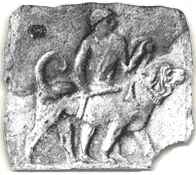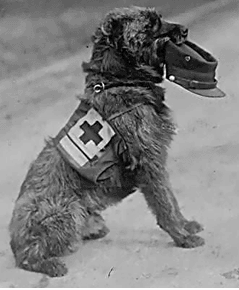|
|
|
 |
|
The History of Dogs
| |
|
Dogs evolved from wolves but they were a product of human selection and not natural selection. Wolves' bones have been found in association with humans as far back as 400,000 years ago, but scientists believe that man's relationship with wolves predates that by several hundred thousand years. |
 |
Early humans probably first used wolves as food. But wolves would also have been using humans, scavenging through their garbage dumps and over time moving closer and closer to the center of camp and the human's food source--the campfire. Eventually, the more docile wolves were accepted by the humans as part of the group. The wolf's social nature and the similarity between wolf packs and early human hunter-gatherer social organizations helped to make the relationship a success. Wolves and humans are both willing to follow a leader, cooperate, and work together to protect members of the group. From Camp Follower to Hunting PartnerWolves began to follow humans when they went hunting for game and the
humans observed that the wolves gave off cues when game was nearby.
Humans learned that wolves could detect prey with their superior sense
of smell, they could track prey with their superior speed, and they
could aid in the search for wounded animals. Man and wolf began to
cooperate and eventually wolves became active participants and true
partners with humans in the hunt for food. It Wasn't a Dog's Life to Begin WithThe Romans bred and trained hunting dogs, guard dogs, sheep dogs, and lap dogs. Over 2,500 years ago, war dogs were used as forward attacking elements by several Southern European armies. These huge dogs, called "Molossus," were capable of knocking a man off a horse. The use of dogs in war spread throughout Europe and then to the Americas. In the sixteenth century, Spanish conquistadors used kill-trained greyhounds and large mastiff-style dogs against Native Americans, to assist in their conquest of the New World.
During the Civil War, dogs were used for sentry duty and to guard prisoners, and they accompanied troops as mascots. In World War I, dogs served multiple roles as a sentry, red cross dog, messenger dog, and ambulance dog. Dogs were trained to detect enemy forces, to carry messages, to search the battlefields for wounded soldiers and evacuate the wounded by pulling small ambulance carts. Dogs also cheered up soldiers at the front and the wounded in hospitals. During World War II America really got serious about using dogs to protect its military and military related property. Scout dogs were also used to good advantage in Vietnam and served double duty as security dogs. Mine detector dogs and tunnel dogs were both trained during this conflict. Vietnam saw the development of the tracker dog. Tracker dogs were used to hunt down and reestablish contact with the enemy, so that the enemy could be destroyed.
The organized use of dogs in law enforcement for the apprehension of criminals was established in the early 1900s. The idea of using dogs for police work was largely brought about by the development and organization of purebred dog clubs. The earliest examples of police dog programs were those of Germany, Belgium, and England. A Friend as Well as a PartnerDogs and humans have a relationship that is based on mutual support.
Dogs have been successful as a species because they have adapted well to
the needs and desires of humans for loyalty, companionship, and
assistance. Dogs and people communicate effectively through voice, body
language, and facial expressions, though in many ways dogs are much
better at understanding humans than humans are at understanding dogs. |
|




